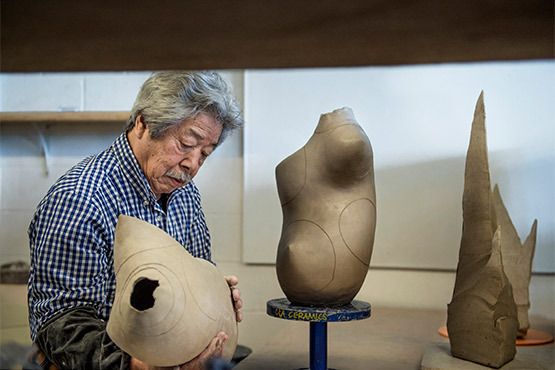
News . Feature Stories . Visiting artist: Yasuhisa Kohyama
News
April 28, 2016
Visiting artist: Yasuhisa Kohyama
Ceramics artist built career from centuries-old inspiration

By Karen Sandstrom
Yasuhisa Kohyama was only a child when his drawing skills earned him a professional gig. This was the 1940s, and Japanese families didn’t typically have cameras. So instead of propping up a nice photograph of the deceased at a funeral, a neighboring family hired Yasuhisa, age 11, to paint the person’s likeness for the service. They paid him in art supplies.
Kohyama laughs. “I wanted money,” he says. “Money and candy.”
The event foretold a future in the arts, though not in drawing or painting. While still a teenager, Kohyama went to work for a company that produced ceramic home and garden products. But in 1969, an art dealer suggested he make pottery to look like the antique stuff that used to come out of local wood-fired kilns, and a new life was born.
He has since become an internationally revered artist, with work in museums and private collections across the U.S., Europe and Japan. The Cleveland Museum of Art was the first museum to collect a Kohyama ceramic piece, according to Ann Albano, executive director of the Sculpture Center. The center presented a show of his work in 2009.
Kohyama and his partner, Wakae Nakamoto, visited the Cleveland Institute of Art for two weeks this April. With them was friend and colleague Ingrid Lüders, a Cleveland-based master of the Japanese art of Ikebana.
They demonstrated techniques to students and fired work in CIA’s anagama kiln — a free-standing wood-fueled oven. (CIA’s Ceramics department periodically fires the kiln on property donated for the purpose in Kirtland, and CIA student work joined the pieces by the visiting artists.)
Kohyama uses a wood-kiln at home in Shigaraki, one of six old kiln sites — some dating to the 13th century — in Japan.
The form of his vessels are inspiration by nature, the elements, and the human body. The earth-toned surface textures are achieved not through glazes, but from the wood ash that floats through the kiln and falls onto the surface of the work.
The makeup of the clay itself is important to the look. While at CIA, Ceramics professor William Brouillard “came up with an approximate analog that enabled him to work thick. The clay is coarse and has large silica rock inclusions that are visually prominent on the surface.”
To see more of his work, click here.
Latest Headlines view all
-
April 02, 2024
Cleveland Institute of Art students partner with Progressive Art Collection to exhibit Ready, Set, Relay! -
March 04, 2024
Cleveland Institute of Art announces Curlee Raven Holton Inclusion Scholar Program -
November 06, 2023
Collision of art and artificial intelligence creates murky waters for artists, curators and educators
Questions?
For more information about this or other CIA news, contact us here.
Social Feed